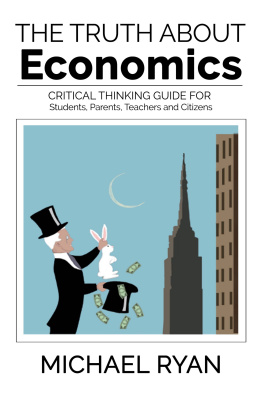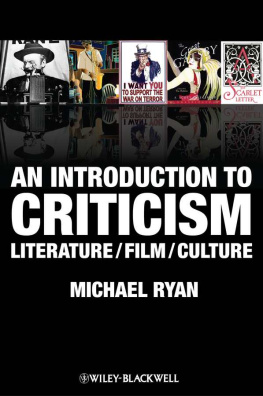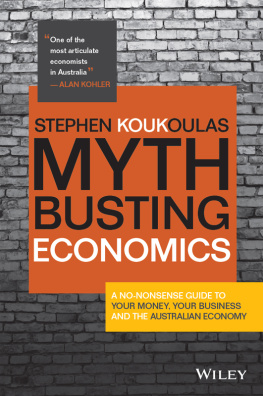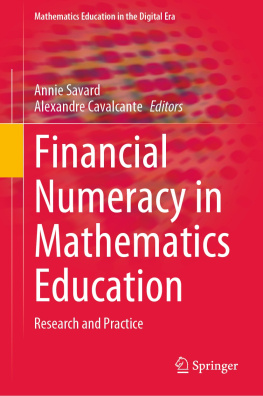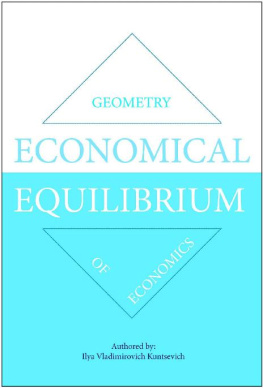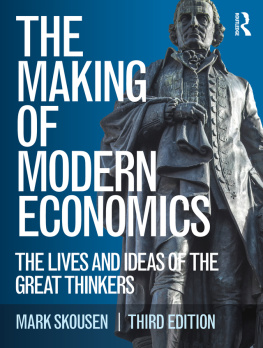The Truth about Economics
A critical thinking guide for
Students, Parents, Teachers and Citizens
Michael Ryan
Columbus, Ohio
The Truth about Economics: A critical thinking guide for Students, Parents, Teachers and Citizens
Published by Gatekeeper Press
3971 Hoover Rd. Suite 77
Columbus, OH 43123-2839
www.GatekeeperPress.com
Copyright 2017 by Michael Ryan
All rights reserved. Neither this book, nor any parts within it may be sold or reproduced in any form or by any electronic or mechanical means, including information storage and retrieval systems without permission in writing from the author. The only exception is by a reviewer, who may quote short excerpts in a review.
ISBN: 9781619848337
eISBN: 9781619848320
Printed in the United States of America
Praise for The Truth about Economics
"High school students who read this book will face a dilemma. On one side they will find it hard afterward to navigate the confusions of textbook economics, and they may incur the impatience, even the wrath, of their teachers. On the other, they will have read a small jewel of clear thinking. And that could serve them well, later in life. May they choose wisely. -- James K. Galbraith, Lloyd Bentsen Jr. Chair in Government and Professor of Government at The University of Texas at Austin
Students expect course material presented by a professor to be truthful and honest. This book demonstrates that supply and demand curves are completely unfounded, and instead promotes investigation, logic, truth, and the mental practice of questioning political doctrine, all of which are vital for the development of our education systems and society as a whole. -- Nolan Glubke, St. Edwards University" -- Student
"A novel approach to economics; it takes it out of the classroom into the boardroom. It challenges traditional thinking on the subject and converts the principles of economics into a useful and practical financial planning guide for ones individual needs through life. Joseph Frisz, retired executive.
This book is dedicated to the industrious students, young or old, who want to know how economic systems truly work.
This book is dedicated to the parents who want their children to learn how to prosper in our demanding and fast changing economic community.
This book is dedicated to those who will join the effort to change our educational system to ensure our children are taught relevant and meaningful economic concepts commonly referred to as financial literacy.
Introduction
How This Book Came About
N ever in my life did I expect to write a book. My initial career path had nothing to do with writing books. Instead, my early career was analytical, finding ways to use technology to solve business problems. My formal training included engineering and finance, with degrees from Texas A&M University and University of California Berkeley. This formal training enabled me to conceptualize and build bridges between technology and economics, making businesses more profitable. It was a rewarding career that allowed me to retire early and pursue avenues to give back to the community. One such avenue was teaching high school as a second career. Most classes I taught were related to mathematics, except for one random assignment to teach an economics class. Once I stumbled across the pervasive faulty logic that serves as the foundation of economics as taught today, I had to expose it.
As a teacher, I have always needed to explore the material at an exhaustive level in order to properly convey my understanding to a classroom of students with varying degrees of interest and capabilities. One explanation might work for one group of students, while a second might be required for a different group of students. This approach was fostered by my engineering training and is rooted in my innate curiosity about how things work. In the past, my curiosity has driven me to take things apart that probably should have stayed together. The carburetor in my 69 Chevy is a great example of something better left alone.
I approached the curriculum as I had approached the carburetor. The curriculum was disassembled and explored far beyond the intentions of the original manufacturer. To help with the exploration, I joined the online AP Economics Teacher Community as a source for further clarification. Soon, I found economic laws that conflicted with basic rational thought. My engineering mind just kept asking questions, digging deeper and deeper. My technology training demanded the resolution of why, why, why? The explanations from the AP community resources were fraught with circular logic.
At one point, I was told I didnt understand the math. Thems fighting words. Any self-respecting engineer would not take such a comment lying down. The result is this book, which provides a complete exposure of how and why the theories involving supply and demand curves, originally conceived long ago, are incorrect and inadequate for explaining anything related to modern economics. At best, the theories are academic wall paper, created years ago as universities sparred for the Crown of Economics within Academia. The theories are now faded and torn, irrelevant, and mysteriously kept in place for some obscure purpose.
This book takes a structured rational approach to explaining the errors of old economic theories and their irrelevance to the economy of today. Readers with the patience and willingness to think critically will be greatly rewarded. They will learn why the old theories should be discarded. They will learn that there are several types of markets, including product markets, labor markets, and security markets. They will learn the six factors that affect the market for products, and the subsequent price one must pay. Later books in the series will delve into factors affecting labor and security markets.
Some of the concepts covered may be unfamiliar to many people. However, everyone can benefit from reading this book. The difference between financial literacy and the out of date economics curriculum is something everyone should understand. Anyone who is taking an economics class, or has a student or friend in an economics class, will discover a treasure of discussions this book creates, revealing financial literacy as the knowledge they need.
During my research, I was often told that economists do not use supply and demand curves in real life. When asked why the topics are still taught, the answer was that students would encounter the material and needed to be familiar with the concepts. The problem with this approach is that the students are never told that supply and demand curves fail to reflect reality. Instead, they are left with the impression that supply and demand curves represent the founding principles of economic science.
A relevant quote:
This is what economics now does, it tells the young and susceptible (and also the old and vulnerable) that economic life has no content of power or politics because the firm is safely subordinate to the market and the state, and for this reason it is safely at the command of the consumer and citizen. Such an economics is not neutral. It is the influential and invaluable ally of those whose exercise of power depends upon an acquiescent public. John Kenneth Galbraith (1973)
People often say the system is rigged. Few understand that it starts with our own educational system, shaped and crafted by academia to develop an acquiescent public. Paul Samuelson is beyond any doubt the leading crusader in promoting the ideology to the American public.

